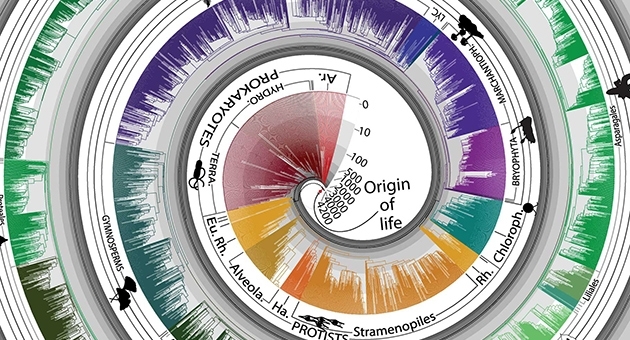Tree of life shows clocklike emergence of new species

College of Science and Technology researchers have assembled the largest and most accurate tree of life calibrated to time. Surprisingly, it reveals that life has been expanding at a constant rate, not slowing down.
The Temple team’s tree of life is depicted in a new way—a cosmologically inspired galaxy-of-life view—and contains more than 50,000 species spiraling out from the origin of life.
The paper “Tree of Life Reveals Clock-Like Speciation and Diversification” is published in the online edition of Molecular Biology and Evolution.
"The constant rate of diversification we found indicates that ecological niches of life are not being filled up and saturated,” said Laura H. Carnell Professor of Biodiversity S. Blair Hedges, a member of the research team and director of Temple’s Center for Biodiversity.
An ecological niche refers to a species’ interplay with its environment, such as how it eats, reproduces and interacts with the world around it. As niches fill with species and competition for resources intensifies, the rise of new species might be predicted to diminish. “Our results are contrary to this popular alternative model that predicts a slowing down of diversification as niches fill up with species,” Hedges said.
For the massive effort, researchers painstakingly assembled data from 2,274 molecular studies and built new computer algorithms and tools to synthesize this collection of evolutionary peer-reviewed species diversity timelines, the largest published to date.
The study also challenges the conventional view of adaptation being the principal force driving species diversification. Instead, the findings underscore the importance of random genetic events and geographic isolation in speciation—the biological process by which new species arise. The researchers found that it takes about 2 million years on average for a new species to emerge onto the scene.
“This finding shows that speciation is more clocklike than people have thought—that speciation and diversification are separate processes from adaptation, responding more to isolation and time,” said Hedges. “Adaptation is definitely occurring, so this does not disagree with Darwinism. But it goes against the popular idea that adaptation drives speciation.”
Besides the new evolutionary insights gained in this study, the time tree of life will provide opportunities for researchers to make other discoveries across disciplines, wherever an evolutionary perspective is needed. Examples include studies of disease and medicine and the effect of climate change on future species diversity.
These new results add to the decadelong efforts of the Timetree of Life (TTOL) initiative, which includes internet tools and a book. TTOL is led by Hedges and Sudhir Kumar, Laura H. Carnell Professor of Genomic Medicine and director of the Institute for Genomics and Evolutionary Medicine at Temple.
“The ultimate goal of the TTOL is to chart the timescale of life—to discover when each species and all their ancestors originated, all the way back to the origin of life some 4 billion years ago," said Hedges.
As an ongoing service to the scientific community, Hedges and Kumar plan to continue adding new data to TTOL from future peer-reviewed studies. They also will improve their current tools, including web and smartphone apps, and develop new tools that will make it easier to access the information and to explore the TTOL, and for scientists to update the growing tree with their new data.
-Joseph Caspermeyer